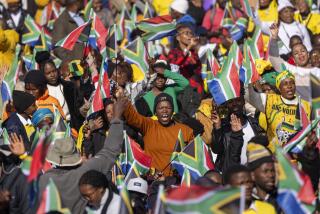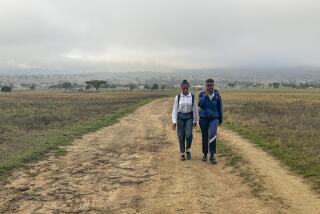Victims in 1976 Soweto Student Uprising Remembered : South Africa: Nelson Mandela warns of mass protests if demands for a new government and constitution are not met.
- Share via
SOWETO, South Africa — The 1976 Soweto student uprising, which sparked a generation of black resistance to apartheid, was remembered on its 15th anniversary Sunday by thousands of South Africans, from the mother of the first young victim to the leader of the African National Congress.
In the treeless Avalon Cemetery of Soweto, Dorothy Pietersen and two dozen friends huddled early Sunday near the grave of her son, Hector Pietersen. It was on such a cold, sunny morning that 13-year-old Hector and several dozen other students were killed by police while protesting the government’s insistence that arithmetic and social studies be taught in Afrikaans, the language of the Dutch-descended white settlers who control the government.
For years, Hector’s annual memorial service opened a day of bloody confrontation between oppressed blacks and a white government committed to retaining power.
But this year, with the legal pillars of apartheid set to fall within days and the government promising democratic elections, “Soweto Day” finally became a part of South Africa’s distant history. The call to arms it once engendered became, on Sunday, a call for peace and black unity.
“The most fitting tribute we can give to Hector is that we come together and end our internal fighting,” said Carter Seleka, assistant secretary general of the anti-apartheid Pan-Africanist Congress.
ANC leader Nelson Mandela told 20,000 people at a soccer stadium in Soweto that the uprising was “a turning point in the history of our struggle for liberation, a day when the youth took their future in their own hands.”
“By their heroism, their courage and determination, they provided dramatic evidence that apartheid was doomed,” Mandela added.
He said there would be mass protests if the government did not agree to the ANC’s demands for a new constitution and government.
“There can be no compromise on that, everybody must understand that this is our position,” Mandela said.
“We are not going to achieve an elected sovereign constituent assembly or an interim government simply by going to a conference and asking for it. If the government does not listen to us then we are going to use our power and mass action,” he said, referring to boycotts and street protests.
For the first time in 15 years, Pietersen could say that her only son’s death had not been in vain, that the boy in whose name so much blood had been shed could begin to rest in peace.
“Today, everything in this country is coming right,” said the 48-year-old Pietersen. “I think Hector would have been pleased.”
The Rev. Dale White unveiled a new granite headstone for Hector on Sunday. It is engraved with the words: “Zolile Hector Pietersen. Deeply mourned by his parents, sisters and a nation that remembered. . . .”
Hector “was one who fell at the beginning of the beginning of change,” White said. “And many South Africans have come to change because of the witness of our fallen comrade.”
A famous photograph from that day shows Hector’s mortally wounded body being carried in the arms of a sobbing friend. The killings triggered an uprising that quickly spread to other townships, with the death toll eventually exceeding 600, and it spawned international condemnation of the South African government.
The government backed down on the mandatory use of Afrikaans as a medium of instruction, but the education system--which still spends several times more educating whites than blacks--became the target of widespread boycotts and vandalism.
That legacy is one of the greatest hurdles facing a future government in South Africa. An entire generation of young blacks now walk the township streets without the education or skills necessary to obtain jobs, and their presence has contributed to escalating crime and rampant unemployment.
More to Read
Sign up for Essential California
The most important California stories and recommendations in your inbox every morning.
You may occasionally receive promotional content from the Los Angeles Times.














